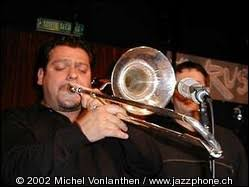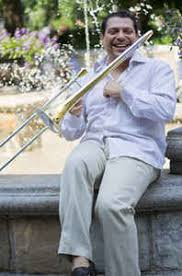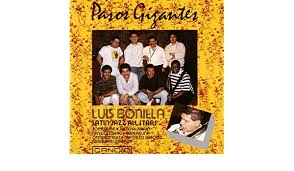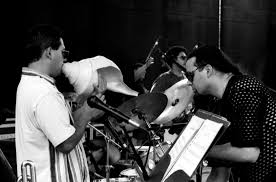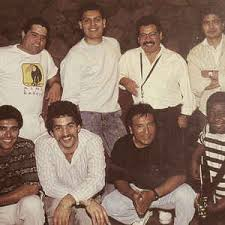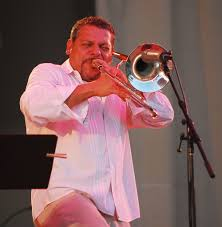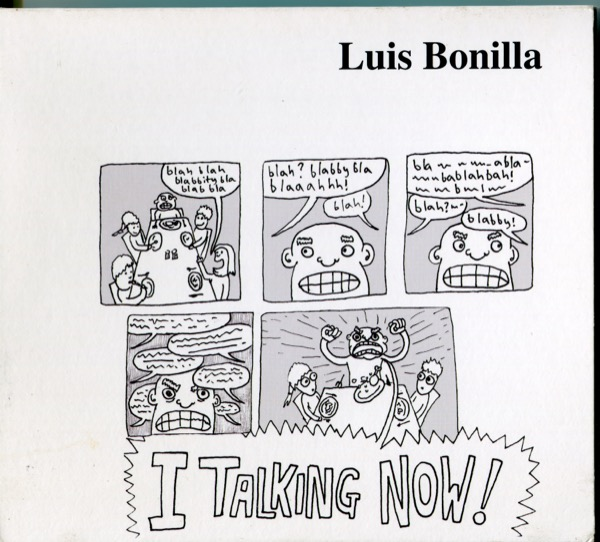Biography of Luis Bonilla
Submitted by Professor Rich Falco. Interview by Tom Bellino (Planet Arts)
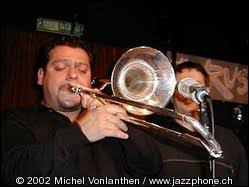
“Luis Bonilla is a fabulous player; his shimmering notes and fabulous bursts of pure joy engulf these eight tracks without suffocating the other musicians.”
-Jon Neudorf, Sea of Tranquility
Luis Bonilla Biography:
If ever an artist could be called an octopus, Luis Bonilla is it. The California raised, Costa Rican trombonist, composer and arranger has sought out, taken in and mastered an incredible array of musical styles. His success as a sideman with such greats as McCoy Tyner, Dizzy Gillespie, Lester Bowie, Tom Harrell, Freddie Hubbard, Astrud Gilberto, Willie Colon and Toshiko Akiyoshi attests not only to the skill and variety of Bonilla’s talent, but also to a mind restlessly committed to exploring some of the most complex and demanding music of our time.
Yet there is nothing rarefied about the Bonilla experience. He has worked as a studio musician with Tony Bennett, Marc Anthony, La India and Mary J. Blige and understands and exploits the liveliness of pop as well as the rhythmic sway and punch of Latin Jazz. Currently a member of the Vanguard Jazz Orchestra, the Afro- Latin Jazz Orchestra under Arturo O’Farrill’s direction (both 2009 Grammy winners) and Dave Douglas’s latest group (Dave Douglas & Brass Ecstasy), Bonilla is one of those rare artists whose work is always expanding, taking in more and more while remaining singular and focused: “Bonilla may be a trombonist used to handling that big long sliding thing, but when it comes to execution of his ideas, he lets nothing slide” (All About Jazz).
Critics praised his first two albums on the Candid label, Pasos Gigantes (1998) and iEscucha! (2000), acknowledging Bonilla’s ability to give voice to radically different musical sensibilities with an ease and seamlessness that belies the rigor and sophistication of the music. Pasos Gigantes made Jazziz’s top ten Latin list of 1998. Even as early as these first two albums, critics noted Bonilla’s leadership and sophisticated use of tonal colors.
As a faculty member at both Temple University and Manhattan School of Music, Bonilla has an intuitive sense in how to bring out the best in those working with him. Listen to any of his albums and you will hear an extraordinary level of trust and inspiration in each band member’s playing. As the critic for All About Jazz noticed, “Bonilla gives his colleagues ample space to breathe, adding momentum to the flow of his compositional ideas.”
His next album, 2007’s Terminal Clarity was a celebration, reflection and aesthetic extension of his years working with Lester Bowie. While retaining the brash harmonic structures of his mentor’s work from Brass Fantasy to his earlier and justly famous work with the Art Ensemble of Chicago, Bonilla adds a “contagious exuberance” (Jazzwise magazine) that is at the heart of his artistic vision. Without in any way diminishing Bowie’s audacity, Bonilla manages to balance “the cerebral and the down- and-dirty (Jazz Times), taking “bold steps to merge Latin genres, free jazz and a variety of other influences (Latin Jazz Corner).
In Bonilla’s latest album, I Talking Now! (2009), he pushes these disjunctions even harder, politely demanding that we feel connections between wildly disparate styles of music. A heady mix of swing, rock, free jazz, funk, movie soundtracks, avant-garde noise and ballads, I Talking Now, for all its musical diversity, speaks with one voice. It is a distinctly American vision, a gentle craziness that suggests that every one and every sound can co- exist if we just keep on taking in more and more. Luis Bonilla is moving in directions that are expanding our notions of jazz and leading us into startling new realms with “remarkable creativity and versatility” (Newsday).
Bonilla served on the music faculty of Temple U., NEC, Manhattan School of Music, New School, Queens College. He currently holds the position of Professor of jazz trombone/jazz studies at the Universitat fur Musik und darstellende Kunst in Graz, Austria and is Director of the JMI World Jazz Orchestra.
FOR FURTHER INFORMATION ON LUIS BONILLA GO TO: WWW.TROMBONILLA.COM
_________
„Luis Bonilla ist ein großartiger Spieler. Seine schimmernden Töne und fabelhaften Freudenschübe verschlingen diese acht Tracks, ohne die anderen Musiker zu ersticken. “
-Jon Neudorf, Meer der Ruhe
Luis Bonilla Biografie:
Wenn jemals ein Künstler als Tintenfisch bezeichnet werden könnte, ist es Luis Bonilla. Der in Kalifornien aufgewachsene costaricanische Posaunist, Komponist und Arrangeur hat eine unglaubliche Vielfalt an Musikstilen gesucht, aufgenommen und gemeistert. Sein Erfolg als Sideman mit Größen wie McCoy Tyner, Dizzy Gillespie, Lester Bowie, Tom Harrell, Freddie Hubbard, Astrud Gilberto, Willie Colon und Toshiko Akiyoshi zeugt nicht nur von der Fähigkeit und Vielfalt von Bonillas Talent, sondern auch von einem unruhigen Geist engagiert sich für die Erforschung einiger der komplexesten und anspruchsvollsten Musik unserer Zeit.
An der Bonilla-Erfahrung ist jedoch nichts Verdünntes. Er hat als Studiomusiker mit Tony Bennett, Marc Anthony, La India und Mary J. Blige gearbeitet und versteht und nutzt die Lebendigkeit des Pops sowie das rhythmische Schwanken und Schlagen des Latin Jazz. Bonilla ist derzeit Mitglied des Vanguard Jazz Orchestra, des Afro-Latin Jazz Orchestra unter der Leitung von Arturo O'Farrill (beide Grammy-Gewinner 2009) und der neuesten Gruppe von Dave Douglas (Dave Douglas & Brass Ecstasy). Bonilla ist einer der seltenen Künstler, deren Werk es ist Immer weiter expandieren, immer mehr aufnehmen und dabei einzigartig und konzentriert bleiben: „Bonilla mag ein Posaunist sein, der es gewohnt ist, mit diesem großen, langen, gleitenden Ding umzugehen, aber wenn es um die Umsetzung seiner Ideen geht, lässt er nichts gleiten“ (All About Jazz).
Kritiker lobten seine ersten beiden Alben auf dem Candid-Label Pasos Gigantes (1998) und iEscucha! (2000), in dem Bonillas Fähigkeit anerkannt wird, radikal unterschiedlichen musikalischen Empfindungen mit einer Leichtigkeit und Nahtlosigkeit Stimme zu verleihen, die der Strenge und Raffinesse der Musik widerspricht. Pasos Gigantes erreichte 1998 die Top-Ten-Latin-Liste von Jazziz. Bereits bei diesen ersten beiden Alben bemerkten Kritiker Bonillas Führungsrolle und den raffinierten Einsatz von Klangfarben.
Als Fakultätsmitglied an der Temple University und der Manhattan School of Music hat Bonilla ein intuitives Gespür dafür, wie man das Beste aus seinen Mitarbeitern herausholt. Hören Sie sich eines seiner Alben an und Sie werden ein außergewöhnliches Maß an Vertrauen und Inspiration in das Spiel jedes Bandmitglieds hören. Wie der Kritiker von All About Jazz bemerkte, "gibt Bonilla seinen Kollegen viel Raum zum Atmen und verleiht dem Fluss seiner kompositorischen Ideen zusätzlichen Schwung."
Sein nächstes Album, Terminal Clarity 2007, war eine Feier, Reflexion und ästhetische Erweiterung seiner Jahre bei Lester Bowie. Während Bonilla die frechen harmonischen Strukturen der Arbeit seines Mentors von Brass Fantasy bis zu seiner früheren und zu Recht berühmten Arbeit mit dem Art Ensemble of Chicago beibehält, fügt er einen „ansteckenden Überschwang“ (Jazzwise Magazine) hinzu, der im Zentrum seiner künstlerischen Vision steht. Ohne Bowies Kühnheit in irgendeiner Weise zu beeinträchtigen, gelingt es Bonilla, „das Gehirn und das Down-and-Dirty (Jazz Times) in Einklang zu bringen und mutige Schritte zu unternehmen, um lateinamerikanische Genres, Free Jazz und eine Vielzahl anderer Einflüsse (Latin Jazz Corner) zusammenzuführen.
In Bonillas neuestem Album I Talking Now! (2009) drängt er diese Disjunktionen noch härter und fordert höflich, dass wir Verbindungen zwischen wild unterschiedlichen Musikstilen spüren. I Talking Now ist eine berauschende Mischung aus Swing, Rock, Free Jazz, Funk, Filmmusik, avantgardistischem Lärm und Balladen und spricht bei aller musikalischen Vielfalt mit einer Stimme. Es ist eine ausgesprochen amerikanische Vision, eine sanfte Verrücktheit, die darauf hindeutet, dass jeder einzelne Klang nebeneinander existieren kann, wenn wir immer mehr aufnehmen. Luis Bonilla bewegt sich in Richtungen, die unsere Vorstellungen von Jazz erweitern und uns dazu bringen, mit „bemerkenswerter Kreativität und Vielseitigkeit“ (Newsday) neue Bereiche zu erschrecken.
Bonilla diente an der Musikfakultät von Temple U., NEC, der Manhattan School of Music, der New School und dem Queens College. Derzeit ist er Professor für Jazzposaune / Jazz an der Universität für Musik und darstellende Kunst in Graz und Direktor des JMI World Jazz Orchestra.
Weitere Informationen zu LUIS BONILLA finden Sie unter: WWW.TROMBONILLA.COM


